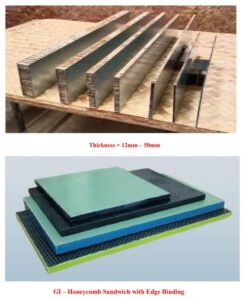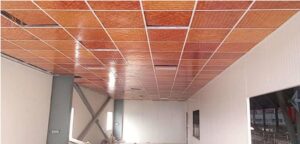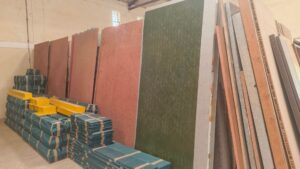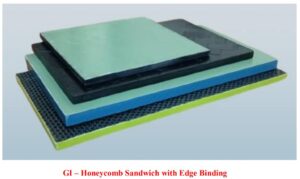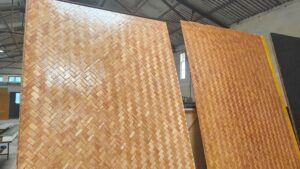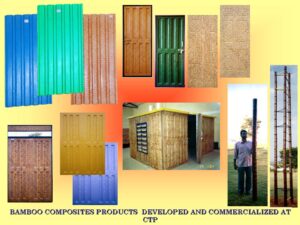In advanced material engineering the intersection of sustainability and high-performance often lies in hybrid composites. One such material gaining traction is the bamboo–carbon fibre hybrid composite sheet, in the 4–6 mm thickness range. These sheets combine the natural, renewable fibre resource of bamboo with the high-strength, high-stiffness reinforcement of carbon fibre, resulting in an engineered composite sheet ideal for demanding applications in architecture, defence, mobility and furniture.
What Are Bamboo–Carbon Fibre Hybrid Composite Sheets?
The hybrid composite sheets are manufactured by layering woven bamboo mats (often woven NF-B: natural fibre-bamboo) with carbon fibre fabrics or layers, impregnating with suitably chosen resin (e.g., phenol-formaldehyde or other high-performance thermosets) and then hot‐pressing under aerospace-derived processing conditions. According to the product data sheet found in the specification document, the “Bamboo-Carbon Fibre Composite (M) sheets” are described with the following details:
They are manufactured by combining woven NF-B (bamboo mat) and carbon fibre, resin impregnated and hot compression moulded using aerospace spin-off technology.
Example thicknesses are 4.2 mm, 5.5 mm and 7.2 mm for this series (in the sheet titled “Table: Thickness vs Weight/Density of Carbon Fibre NF-B Composite Sheets”).
The volume density (kg/m³) for these thicknesses are given as ~1182 kg/m³ (for 4.2 mm) and ~1109 kg/m³ (for 5.5 mm).
These sheets are specified as eco-friendly and sustainable, light weight, high strength, moisture/water resistant, non-corrosive, termite proof, thermally and electrically insulating, and impact resistant.
Thus these sheets represent a serious leap from simple bamboo laminate boards: the addition of carbon fibre (a high-performance synthetic reinforcement) boosts stiffness, strength and structural capability, while bamboo brings renewability and biogenic fibre content.
Engineering Benefits & Key Properties
Here we summarise why the hybrid combination works and what properties the sheets deliver:
High Strength and Stiffness: The carbon fibre layer contributes high tensile strength and modulus, while the bamboo mat provides a matrix of fibre reinforcement, resulting in hybrid behaviour superior to bamboo alone. For example, the data shows a density of ~1182 kg/m³ at 4.2 mm thickness — that points to a heavy high-density composite capable of structural use.
Lightweight Relative to Steel or Traditional Metals: The specification notes significant weight reduction compared to steel (e.g., %Weight Reduction compared to steel ~85% for 4.2 mm thickness) in the table for the hybrid sheet.
Dimensional Stability & Durability: The resin impregnation, hot curing and layered construction all contribute to resistance to boil-water, moisture, termite, fungus, corrosion and impact. These are listed among the “Properties” in the product data.
Thermal & Electrical Insulation: The hybrid sheet is described as offering thermal and electrical insulation benefits. This is useful in defence, marine or interior environments where insulation matters.
Sustainable Fibre Content: By incorporating bamboo (a rapidly renewable resource), the composite offers improved eco-credentials compared to fully synthetic fibre composites. The specification emphasises “Eco-Friendly and sustainable”.
Applications of Bamboo–Carbon Fibre Hybrid Sheets (4–6 mm)
Given these properties, here are the practical application domains:
Aerospace, Defence and Marine Interiors: The specification explicitly mentions “drone, aircraft, defence, marine, railways, automobile parts etc.” for these hybrid sheets.
High-End Furniture and Architectural Panels: The sheet can be used for decorative panels, feature walls or joinery where structural strength, thin thickness and premium look matter. Because it can be cut/joined and finished like wood composites, yet perform at higher levels, it is suited for premium interiors.
Vehicle Components & Mobility Applications: In automotive or light vehicles one could use these sheets for lightweight structural panels, interior cladding or components where strength-to-weight ratio matters.
Marine or Ship/Boat Building: The termite/fungus/moisture resistance makes these sheets appropriate for boat interiors, bulkheads, hatch covers or other marine joinery.
Architectural Cladding and Infrastructure: For façade panels or interior wall/ceiling systems requiring both strength and sustainability, this material presents an appealing option.
Pros & Cons
Pros
Strong hybrid performance: combining bamboo fibre and carbon fibre layers gives high mechanical properties in a sheet form factor.
Weight savings: The weight reduction compared to steel or heavier materials offers structural benefits.
Sustainability: Use of bamboo mat content increases biomass-based renewable component.
Multi-functional: Offers not just mechanical performance but also moisture resistance, termite/fungus protection, thermal/electrical insulation.
Thin sheet format: At 4–6 mm thickness it is suitable for panel or overlay applications without excessive thickness or burden.
Workability: As per the product data, it is compatible with conventional tooling (cut, drill, join) in appropriate contexts.
Cons / Considerations
Cost: Carbon fibre and special resin processing introduce higher cost versus conventional plywood or bamboo laminate alone.
Thickness/range limitation: The specified thicknesses (4.2 mm, 5.5 mm, 7.2 mm) mean usage is more for panel form rather than heavy structural components; design must match loads.
Finish and fabrication care: As with any composite sheet, edge sealing, bonding, substrate support, fixation and finish details must be carefully managed.
Supply & specification complexity: As a hybrid advanced material, specifying details (resin type, core lay-up, bonding, certification) may require more engineering input than basic panels.
Environmental end-of-life: While bamboo content is renewable, the carbon fibre/resin system may still create challenges in recycling or disposal compared to pure natural fibre composites.
Frequently Asked Questions (FAQs)
Q: What thickness options are available for these bamboo–carbon fibre hybrid sheets?
According to specification data, thicknesses given include 4.2 mm, 5.5 mm and 7.2 mm. For the 4–6 mm range one would typically select the 4.2 mm and 5.5 mm variants.
Q: How much weight savings do these sheets offer compared to steel?
In the data sheet, the 4.2 mm thickness is listed with a %Weight Reduction compared to steel of ~85%. This indicates a substantial reduction in weight for equivalent structural form.
Q: Can these sheets be used outdoors or in humid/hostile environments?
Yes. The sheets are specified as water/moisture resistant, non-corrosive and termite proof. The composite manufacturing ensures durability in challenging conditions.
However appropriate finishing and installation detail must be observed for outdoor exposure.
Q: Are these sheets suitable for furniture fabrication?
Yes. The specification mentions interior decoration, furniture, architectural cladding as application areas for the related bamboo composite products. The thin hybrid sheet offers premium finishes with high performance.
Q: How do these hybrid sheets compare in sustainability to traditional carbon fibre composites?
The inclusion of bamboo mats increases the renewable content of the composite, reducing reliance purely on synthetic fibres. While still incorporating carbon fibre/resin, the hybrid approach improves eco-credentials relative to full carbon fibre laminates.
Q: What machining or fabrication methods are recommended?
The product data indicates the composite is compatible with conventional cutting, drilling, joining, bonding techniques used in woodworking or panel fabrication. Proper tooling for composite materials should still be used.
Q: What are the main design considerations in specifying this material?
Key considerations include: support/ substrate backing (because sheet thickness is moderate), fixings and joints appropriate to composite panel rather than plain wood, edge sealing for moisture protection, matching finish/appearance expectations, and understanding cost/lead time for advanced composite material.
Conclusion
The bamboo–carbon fibre hybrid composite sheet (4–6 mm range) embodies a sophisticated engineering approach that merges natural fibre sustainability with high performance synthetic reinforcement. It caters to architects, designers and engineers who want a panel form material that delivers strength, durability, lightweight structure and aesthetic flexibility while advancing ecological credentials.
When specifying such a material, careful attention to fabrication, installation, finishing and lifecycle is important. But the reward is a material that stands out in both function and form—ideal for modern interiors, mobility systems, defence and architectural applications where both performance and sustainability matter.
If you like, I can prepare a comparison chart between three similar composite sheet types (bamboo laminate only, bamboo–carbon fibre hybrid, full carbon fibre composite) showing properties like density, strength, weight reduction, sustainability metrics—would that be useful?

